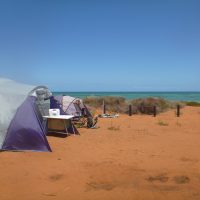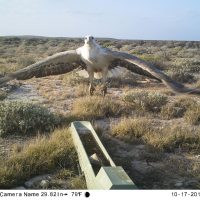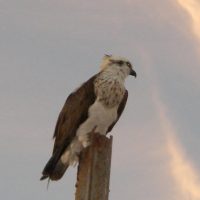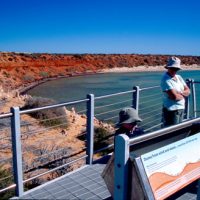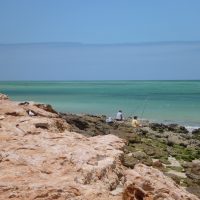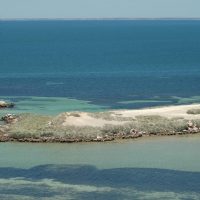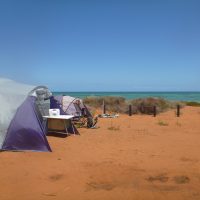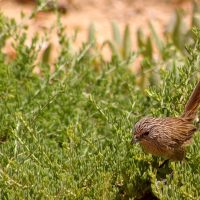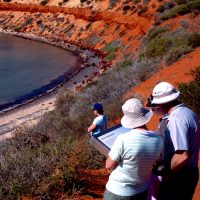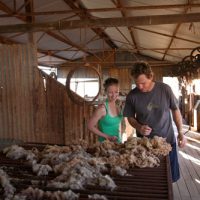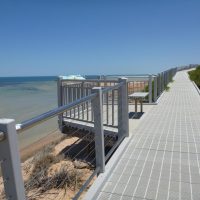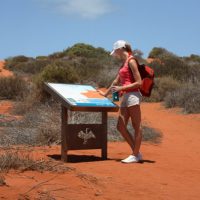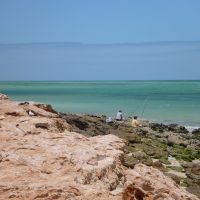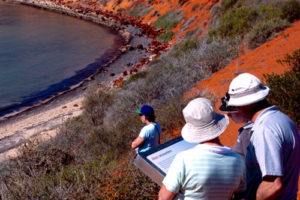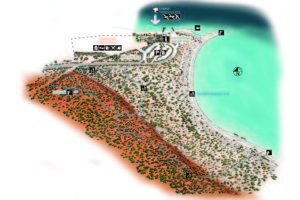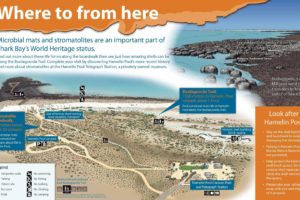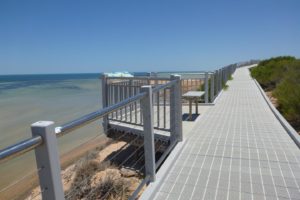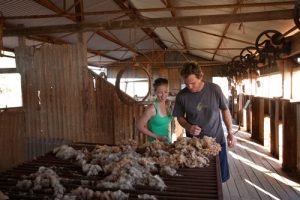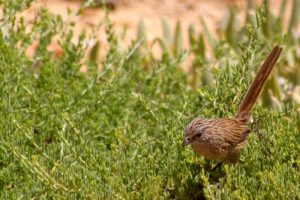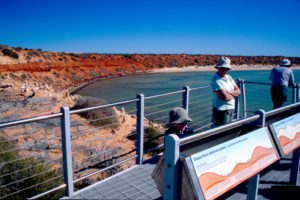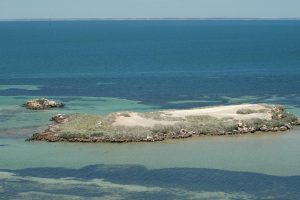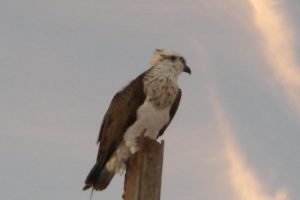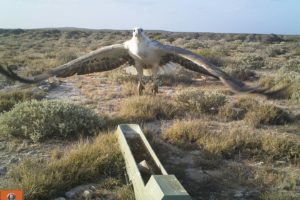Things To Do On Land
Shark Bay has a variety of activities for nature-lovers to enjoy, see below for things to do on land.
You can experience some of the bay’s most spectacular natural attractions along a number of short walks. Longer walking trails are not provided due to the warm climate and lack of fresh water.
If you would like to go for a longer walk, make sure you are well prepared and discuss your plans with the Parks and Wildlife Service office in Denham.
Wanamalu Trail
Connecting Skipjack Point and Cape Peron in Francois Peron National Park this trail has excellent views of marine life from the cliff top, striking scenery and great photographic opportunities.
Distance: 1.5km one-way
Time: 45min
Grade: Easy to moderate – soft sand can make it hard going in summer
Wulyibidi Yaninyina Trail
The trail leads through different landscapes, starting at the Monkey Mia carpark and winding through red sand dunes and along a section of coastline.
Distance: 3 km loop
Time: 1 – 1 ½ hours
Grade: Easy to moderate – soft sand can make it hard going in summer
Hamelin Pool Stromatolite boardwalk & Boolagoorda Trail
The Boolagoorda trail links Hamelin Pool Telegraph Station with the stromatolite boardwalk and features a shell quarry, grave site and remains of the old telegraph line. The boardwalk extends out over the water for easy viewing of the microbial mats, microbialites and stromatolites and is the most accessible place in the world for viewing stromatolites.
Distance: 750m each way + 300m boardwalk
Time: 30 – 45min
Grade: Easy
Eagle Bluff Boardwalk
This boardwalk is perched on top of the scree slope above the shallow waters of Henri Freycinet Harbour. It has excellent views of two small limestone islands and the marine life that frequents these inshore waters. Rays, sharks, schools of fish and even turtles and dugongs are often seen, especially during summer.
Distance: 300m boardwalk
Time: 20 – 30min
Grade: Easy
Station Life Trail
This short walk explores the Peron Heritage Precinct in Francois Peron National Park. Shearing sheds, holding yards, windmills and an artesian hot tub are all features along this interpreted walk that provides insight into life before the old station became a national park. A small visitor centre features dioramas and other exhibits about the park and Project Eden.
Distance: 500m loop track
Time: 30min
Grade: Easy
Shark Bay’s wildlife credentials make impressive reading. There are more than 10,000 dugongs, it is the best place in the world to see stromatolites, and the Monkey Mia wild dolphin experience is world-renowned.
Shark Bay is also home to some of the Earth’s rarest mammals and is vital for conservation of many species. With time and patience you can have some exceptional wildlife encounters in Shark Bay.
See the fact sheets page for detailed information about some of Shark Bay’s wildlife.
Monkey Mia
Wild Indo-Pacific bottlenose dolphins visiting the beach are the main attraction at Monkey Mia. A little further offshore are dugongs, rays, turtles and other marine animals so a wildlife cruise is worthwhile.
The walking trail around Monkey Mia is great for bird watching. Look out for the thick-billed grasswren, white-browed babblers, chiming wedgebill, southern scrub-robin, and crested bellbird. In summer there are a variety of shorebirds on the mudflats along the coast south of Monkey Ma.
Skipjack Point
Perched on top of the cliffs at Skipjack Point are two lookout platforms with views of marine wildlife in the clear water below. Rays, turtles, cormorants, sharks and schools of fish are common and you may also see dugongs and dolphins. The Wanamalu trail links Skipjack Point with Cape Peron giving you more chances to see wildlife, including cormorants on the beach at Cape Peron.
Eagle Bluff
Sharks, rays, schools of fish and dugongs can be seen from this perfectly placed boardwalk high above Henri Freycinet Harbour. Offshore are two small islands that are home to rock parrots and breeding seabirds such as cormorants and silver gulls. The greatest concentration of wildlife is during summer as many species seek warmer waters further out during winter.
Denham
Without leaving town you can see gulls, cormorants, wrens, ospreys, kestrels and emus. Please do not approach the emus or give them or other wildlife food as this can create problems. Denham is also home to many reptile species including bobtails (large skinks), monitors and thorny devils.
Bird Watching
Top bird watching sites include Francois Peron National Park for bush birds; Monkey Mia for small scrub birds; Little Lagoon for waders and shorebirds; Bush Bay and New Beach on the Wooramel Coast for mangrove species like the striated heron; and Hamelin Pool Telegraph Station for bush birds like the hooded robin and the chestnut-rumped thornbill.
Areas in Shark Bay particularly important for seabirds and shorebirds include Faure Island, the eastern side of Dirk Hartog Island, Pelican Island and the spit on Salutation Island. Faure and Pelican islands and flats around them may be the most important area for migratory shorebirds in Shark Bay.
Most islands in Shark Bay host seabirds and 14 species are known to breed here, including the largest population of pied cormorants in Western Australia. Fairy terns nest on mainland beaches and spits. Another 50 seabird species visit the area.
In winter 50 to 100 pairs of pelicans breed on Pelican Island, one of only 9 or 10 pelican breeding sites in Western Australia. Boats approaching within one kilometre of the island can disturb the birds.
Shark Bay is internationally important for two species of shorebirds, the banded stilt and eastern curlew; and is nationally important for five species – the wood sandpiper, greenshank, grey plover, banded stilt and eastern curlew. The eastern curlew is the largest shorebird migrating to Australia and is considered rare in Western Australia with the Shark Bay population considered significant due to declining numbers elsewhere in Australia.
A species list and a bird watching guide are available on the fact sheet page.
Wildflowers
Western Australia is renowned for its wildflowers and after good winter rains Shark Bay has spectacular displays. In coastal areas Shark Bay daisies creep over bushes and the Tamala Rose adds flashes of pink and red. The yellow tufts of acacias are littered throughout the shrubland and Eremophilas add red and mauve to the landscape.

